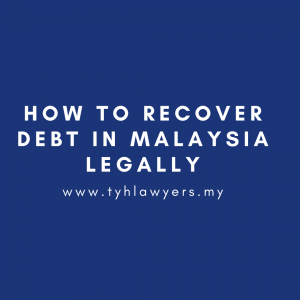How To Recover Debt In Malaysia Legally

How To Recover Debt In Malaysia Legally | Step by step legal guide
Recovering debt especially bad debt may seem to be stressful task for many of you out there. That is why we have come up with this article on how to recover debt in Malaysia legally to demonstrate how you can increase your chance to recover that bad debt.
Step 1 : Initial Preparation
You should identify your debtor and determine whether your debtor is an individual or a company. It would be advisable that a background check be done before you proceed further. For individuals, a search done at the National Registration Department (NRD) and a Bankruptcy search is required to ascertain the individual’s latest residential address and bankruptcy status. For companies, a search done at Companies Commission of Malaysia (CCM) is required to ascertain their registered address, status and financial standing of the Company.
You should also compile all relevant evidence with regards to the debt recovery. The evidence can be in the form of documents, e-mails, correspondences and even WhatsApp conversations.
Finally, you should also check whether you are still within the limitation period. Under the Limitation Act 1950, a creditor has 6 years from the date of default to commence legal action against the debtor. If your action is filed after 6 years, the debtor may apply to strike out your suit in Court.
Step 2 : Issuance of Letter of Demand
Once you engage a law firm, a letter of demand (“LOD”) will be issued on your behalf to the debtor. The LOD will state specifically the amount of debt that is outstanding and the timeframe for the debtor to settle it, failing which legal proceedings will be commenced without any further notice to the debtor.
The issuance of a LOD is not mandatory but it is a good practice to do so where some debtor may choose to settle the debt upon receipt of the said LOD to avoid potential action. This in return would save you considerable cost and fees.
Step 3 : Commencement of Legal Action
Once the timeframe of the LOD expires, a legal action can be commenced by filing a Writ and Statement of Claim. The total amount owing would determine where you would file the action:
| Amount of Debt | Court |
| Below RM5,000.00 | Magistrate Court (Small Claims Procedure) |
| Below RM100,000.00 | Magistrate Court |
| Below RM1,000,000.00 | Sessions Court |
| Above RM1,000,000.00 | High Court |
The Writ and Statement of Claim shall be served on the debtor (which is now regarded as the Defendant) in the suit. After the Writ and Statement of Claim has been properly served to the Defendant, there are three possible scenarios:
- The defendant does not enter appearance
The Defendant shall enter an appearance within 14 days upon receipt of the Writ and Statement of Claim. If the Defendant fails to do so, you may proceed to enter a Judgment in Default of Appearance against the Defendant.
- Summary Judgment
In the event the Defendant enters an appearance but you have strong and compelling documentary evidence against the Defendant, you may proceed to file an application for Summary Judgment. The Court will examine the disputed issues through documentary evidence put forth by you and also the Defendant. If the Court is in your favor, the Summary Judgment will be granted to you without the need to proceed to full trial.
- Full Trial
In the event the Defendant enters an appearance and there are disputed issues that are unable to be determined through documentary evidence, you have no choice but to proceed with the full trial where witnesses from both sides will be called and examined. At the conclusion of the trial, the Court will give its judgment.
Step 4 : Execution of Judgment
After obtaining your judgment, it shall be served on the Defendant, notifying that the Defendant shall pay the judgment sum within the time period failing which you will proceed to execute the judgment without any further notice to the Defendant. The common ways for execution of the judgment are, winding-up proceedings, garnishee proceedings, bankruptcy, writ of seizure and sale, judgment debtor summons and others.
Get Free Consultation & Quotation From Our Debt Recovery Lawyer In Less Than 2 Working Hours Now
This information provided on this website does not, and is not intended to, constitute legal advice; instead all information, content and materials available on this site are for general information purposes only. Information on this website may not constitute the most up-to-date legal or other information. You should consult with appropriate professionals of Tam Yuen Hung & Co or other professional advisors for advice concerning any matters before making any decision.
